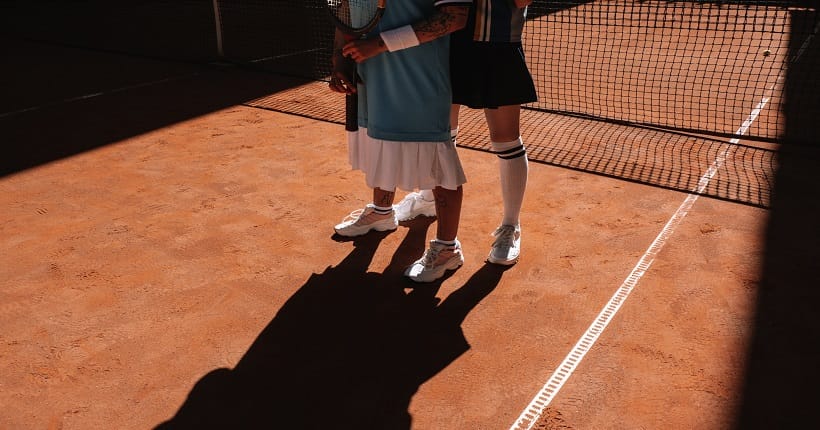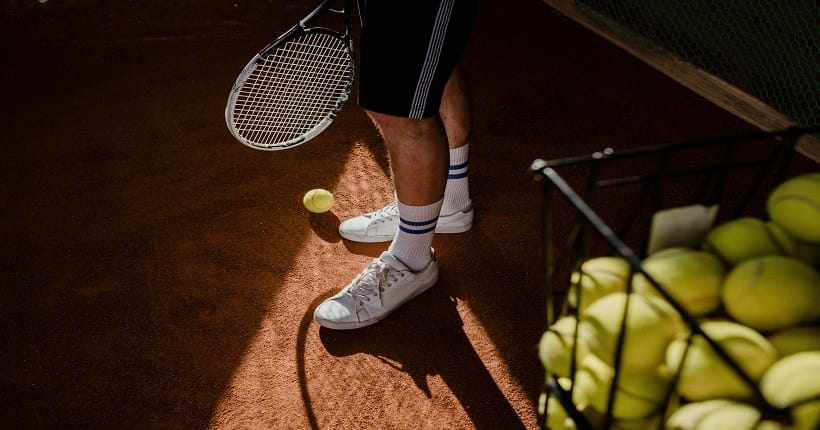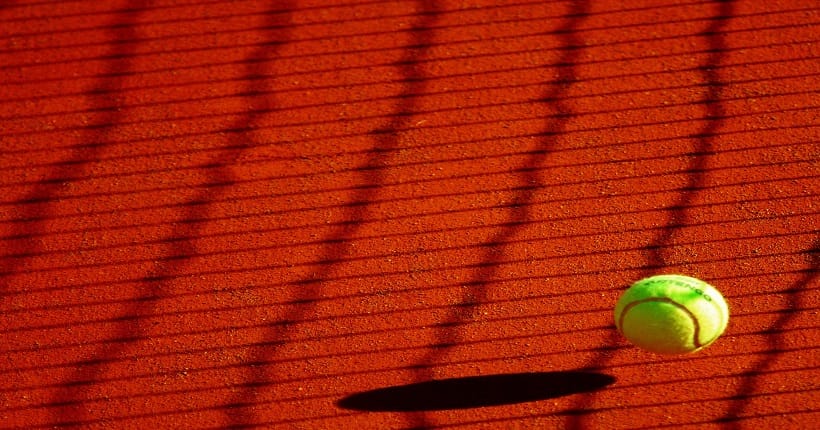How To Win A Tennis Match?
To win a tennis match, focus on mastering your skills and strategies while maintaining a determined mindset and consistent practice. Tennis success depends on honing your abilities, developing effective tactics, and committing to regular training.
The Basics
Overview of tennis rules and scoring system
Tennis is a dynamic sport that combines physical endurance, mental agility, and strategic thinking. To succeed in a tennis match, understanding the basic rules and the scoring system is essential.
The game of tennis is played between two players or two teams of two players each. The objective is to hit the ball over the net and into the opponent’s half of the court, aiming to make it difficult for them to return the shot.
The scoring system in tennis follows a unique pattern. Each game starts at “love” (zero) and progresses with points awarded as follows: 15, 30, 40, with the last point being the game point. If both players or teams reach 40, it is called a “deuce.” From deuce, a player must win two consecutive points to win the game.
In addition to games, tennis matches are divided into sets. Typically, a set consists of six games. To win a set, a player or team must win at least six games with a difference of at least two games. If both players or teams reach a 6-6 tie, a tiebreaker is played to determine the winner of the set.
Importance of physical and mental preparation
Preparing yourself both physically and mentally is crucial for success in a tennis match. A well-conditioned body enhances endurance, speed, and power, while mental strength helps maintain focus and overcome challenges during a match.
Physical preparation involves maintaining overall fitness through regular exercises such as cardiovascular workouts, strength training, and agility drills.
Equally important is mental preparation, which involves developing a positive mindset, managing stress, and staying focused on the game. Strategies such as visualization, deep breathing, and positive self-talk can improve mental resilience on the court.
Mastering the tennis grip and proper footwork
A solid foundation in fundamental techniques is key to becoming a proficient tennis player. Two essential aspects to focus on are mastering the tennis grip and developing proper footwork.
The grip you use on the racket can significantly impact your shot quality and control. The most common grip is the “Eastern Forehand Grip,” where the base knuckle of your index finger is placed on the third bevel of the racket handle. This grip provides a well-rounded balance of power and control.
Proper footwork is essential for quick movement and balance on the court. Key footwork techniques include the split-step, which involves hopping and landing on both feet just before your opponent’s shot, and the side shuffle, which allows you to move swiftly from side to side to reach the ball effectively.

Credit: mentalgameoftennis.com
Effective Serve And Return Techniques
When it comes to winning a tennis match, having effective serve and return techniques can make all the difference in gaining an advantage over your opponent. Mastering these skills not only enhances your overall game but also increases your chances of victory. In this article, we will explore the strategies and tips you can employ to improve your serve power and accuracy, as well as your ability to return serves and gain an advantage.
Enhancing Your Serve Power And Accuracy
Your serve is one of the most important shots in tennis, as it sets the tone for the entire point. Enhancing your serve power and accuracy is essential to keep your opponent on their toes and put them at a disadvantage right from the start.
Strategies for delivering effective serves:
- Focus on proper technique: A successful serve begins with correct form. Stand with your feet shoulder-width apart, toss the ball slightly in front of you, and generate power by using your legs, hips, and core. Practice your motion repeatedly until it becomes natural.
- Vary your serve placement: To keep your opponent guessing, mix up your serve placement. Aim for different corners of the service box, alternating between the deuce and advantage courts. This unpredictability will make it challenging for your opponent to anticipate your shots.
- Utilize different types of serves: Experiment with different serves like the flat serve, slice serve, and kick serve. Each type has its unique advantages and can put your opponent under pressure. Mix them up strategically throughout the match to keep your opponent off balance.
- Develop consistency: Consistency in your serve is key. Practice your placement and power to ensure a high percentage of successful serves. By doing so, you can gain a head start in each point and maintain control.
Tips On Returning Serves And Gaining An Advantage
Returning serves is equally crucial as it allows you to seize control of the point and put pressure on your opponent. Here are some tips to help you improve your returns and gain an advantage.
Tips on returning serves:
- Anticipate your opponent’s serve: Pay close attention to your opponent’s stance, grip, and body positioning. By observing these cues, you can anticipate where the serve will be directed and position yourself accordingly, increasing your chances of a successful return.
- Stay balanced and ready: Prepare yourself for the incoming serve by maintaining a strong and balanced stance. Keep your weight on the balls of your feet, with your knees slightly bent and your racket at ready position. This allows for quick reactions and better control over your returns.
- Practice your timing: Timing is crucial when returning serves. Focus on the moment the ball leaves your opponent’s racket and work on your footwork and racket swing to make a solid connection. Consistent practice will help you develop a discerning eye for timing the ball correctly.
- Vary your return shots: Just as you mix up your serves, varying your return shots can keep your opponent guessing. Experiment with different shot placements, speeds, and spins to disrupt your opponent’s rhythm and make it difficult for them to counter your returns.
By putting these effective serve and return techniques into practice, you can elevate your game and increase your chances of winning a tennis match. Remember to focus on perfecting your serve power and accuracy, as well as honing your return skills to gain an advantage over your opponents. Practice regularly, stay focused, and enjoy the thrill of achieving victory on the court!
Mastering Different Shots And Strategies
Developing A Strong Forehand Technique
To win a tennis match, it is essential to develop a strong forehand technique. The forehand shot is one of the most powerful and frequently used shots in tennis. To improve your forehand, you should focus on:
- Footwork: Position yourself correctly on the court to effectively hit the forehand.
- Grip: Use a continental or semi-western grip for better control and power.
- Swing technique: Practice the proper swing technique with a smooth and continuous motion.
- Timing: Time your shot well to make contact with the ball at the right moment.
By developing a strong forehand technique, you will be able to unleash powerful shots that can put your opponents under tremendous pressure.
Perfecting The Backhand Stroke
The backhand stroke is another crucial shot that can make a difference in winning a tennis match. To perfect your backhand, keep the following tips in mind:
- Grip: Use an eastern or semi-western grip that feels comfortable and provides control.
- Stance: Position yourself correctly, ensuring your body is sideways to the net.
- Preparation: Prepare early by turning your shoulders and positioning the racket appropriately.
- Follow-through: Finish the stroke with a smooth follow-through, extending your arm towards your target.
By practicing these techniques regularly, your backhand stroke will become a reliable weapon in your tennis arsenal.
Mastering The Art Of Volleys And Smashes
Volleys and smashes are key shots to master when it comes to playing at the net. Here are some tips to improve your skills in these areas:
- Positioning: Move closer to the net and focus on getting into the right position.
- Hand-Eye Coordination: Keep your eyes on the ball and time your shots accurately.
- Technique: Use a short and compact swing for volleys to increase control and precision. For smashes, generate power by using your wrist and arm effectively.
- Anticipation: Read your opponent’s shot to prepare yourself for quick reactions at the net.
By mastering volleys and smashes, you can dominate the net and become a formidable player during a tennis match.
Using Topspin And Slice Shots Effectively
Adding topspin and slice shots to your repertoire can give you an edge in a tennis match. Here’s how you can use these shots effectively:
- Topspin: Brush up on the back of the ball with a low-to-high swing to create topspin. This will help your shots clear the net and dip sharply, causing difficulties for your opponent.
- Slice: Slice shots involve brushing down the back of the ball with an open racket face. This imparts backspin, causing the ball to stay low and skid, making it challenging for your opponent to handle.
By incorporating topspin and slice shots into your game, you can keep your opponents off balance and create strategic advantages during a tennis match.
Strategies For Playing Against Different Opponents
Playing against different opponents requires adapting your strategies accordingly. Here are some strategies to consider:
- Baseline players: Against opponents who prefer to stay at the baseline, mix up your shots with variety, such as deep shots, drop shots, and angles, to move them around and disrupt their rhythm.
- Net players: Against aggressive net players, aim for passing shots to exploit the open spaces on the court. Look for opportunities to hit passing shots down the line or cross-court to keep them on their toes.
- Defensive players: Be patient with defensive players and focus on consistency. Force them to hit difficult shots by varying your pace and spin, making it harder for them to retrieve the ball.
By adapting your strategies to different opponents, you can exploit their weaknesses and increase your chances of winning the tennis match.
Adjusting Your Game Plan
Adjusting your game plan is essential to increasing your chances of winning a tennis match. By analyzing your opponent’s strengths and weaknesses, adapting your style of play accordingly, and outsmarting them with strategic shot placements, you can gain a competitive edge on the court.
Analyzing Your Opponent’s Strengths And Weaknesses
Before stepping onto the court, take some time to analyze your opponent’s strengths and weaknesses. By understanding their playing style, you can better predict their moves and strategize accordingly.
- Observing their serve technique and determining its reliability
- Identifying any preferred shots or patterns they frequently use
- Noting their movement and footwork on the court
- Assessing their agility and ability to quickly recover from different positions
Once you have a clear understanding of their strengths and weaknesses, you can adapt your game plan accordingly.
Adapting Your Style Of Play Accordingly
Adapting your style of play is crucial in order to exploit your opponent’s weaknesses and minimize their strengths. Consider the following strategies:
- Changing the pace: If your opponent struggles with fast-paced shots, incorporate quick and powerful hits into your game. Conversely, if they struggle with slow shots, try incorporating more lobs and drop shots into your arsenal.
- Working on their backhand: If your opponent has a weaker backhand, focus on directing shots toward that side of the court. Push them out of their comfort zone and force errors.
- Exploiting weaknesses: If your opponent tends to make more mistakes under pressure, focus on maintaining a consistent game and keeping the pressure on them. Force them into difficult positions and seize opportunities to capitalize on their mistakes.
By adapting your style of play, you can exploit your opponent’s weaknesses and increase your chances of success on the court.
Outsmarting Opponents With Strategic Shot Placements
Strategic shot placements can make all the difference in a tennis match. By carefully considering where and how you hit the ball, you can put your opponent in difficult positions and gain an advantage.
Here are some key shot placement strategies to keep in mind:
| Shot Placement | Objective |
|---|---|
| Deep Shots | Push your opponent further back, limiting their options for offensive shots. |
| Short Angle Shots | Force your opponent to cover more ground, opening up opportunities for winners. |
| Wide Shots | Put your opponent out of position, allowing you to control the point. |
| Drop Shots | Catch your opponent off guard and force them to reach the net, disrupting their rhythm. |
By strategically placing your shots, you can not only keep your opponent on their toes but also create openings for you to capitalize on.
Maintaining Mental Focus And Psychological Advantage
When it comes to winning a tennis match, physical skills and technique are undoubtedly important. However, equally crucial is maintaining mental focus and gaining a psychological advantage over your opponent. Building mental resilience and concentration, utilizing psychological tactics to intimidate opponents, and handling pressure situations with confidence and composure are key aspects in achieving success on the court.
Building Mental Resilience And Concentration
Mental resilience and concentration play a significant role in winning a tennis match. When the pressure intensifies, being able to remain calm and composed can greatly impact your performance. Here are some strategies to improve your mental resilience and concentration:
- Practice mindfulness techniques: Incorporate mindfulness into your training routine to stay present and focused on the current moment. This can be done through meditation, deep breathing exercises, or visualizations.
- Set goals and stay motivated: Establish clear goals for each match and maintain a positive mindset. This will help channel your focus towards achieving those goals and keep you motivated even when facing challenges.
- Develop a pre-match routine: Create a consistent pre-match routine that helps you relax and mentally prepare for the game. This could include physical warm-up exercises, listening to motivational music, or engaging in visualization techniques.
Utilizing Psychological Tactics To Intimidate Opponents
Psychological tactics can be effective in gaining a psychological advantage over your opponents. By unsettling their mental state, you can disrupt their game and increase your chances of success. Here are some psychological tactics to consider:
- Show confidence: Confidence is key in gaining an edge over your opponent. Displaying a strong and composed demeanor, maintaining eye contact, and standing tall on the court can intimidate your opponent and make them question their abilities.
- Use strategic body language: Use assertive body language, such as strong gestures and an upright posture, to convey dominance. Additionally, avoid showing frustration or weakness, as this can empower your opponent.
- Psychological warfare: Engage in subtle psychological tactics during the match, such as changing the pace or tempo of the game, employing unexpected shots, or employing strategic timeouts. These tactics can disrupt your opponent’s rhythm and make them uncertain.
Handling Pressure Situations With Confidence And Composure
Pressure situations are inevitable in tennis matches. Learning to handle these situations with confidence and composure can significantly impact your performance. Here are some strategies to help you stay calm under pressure:
- Focus on the process, not the outcome: Instead of fixating on winning or losing, focus on executing your shots and strategies to the best of your abilities. Trust in your training and let go of the fear of failure.
- Positive self-talk: Develop a repertoire of positive affirmations that you can use during pressure situations. Remind yourself of your abilities and past successes to boost your confidence.
- Control breathing and body tension: Deep breathing exercises can help you manage stress and stay composed during pressure situations. Be mindful of your body tension, and intentionally relax your muscles to release stress.
Physical Fitness And Endurance Training
Physical fitness and endurance play a crucial role in achieving success on the tennis court. Tennis is a demanding sport that requires a combination of strength, speed, agility, and stamina. In this section, we will discuss the importance of cardiovascular endurance in tennis, how to tailor your fitness routine to the specific needs of tennis, and the significance of strengthening core muscles and improving agility.
Importance Of Cardiovascular Endurance In Tennis
Cardiovascular endurance is the ability of your heart and lungs to deliver oxygen to the working muscles efficiently. In tennis, where matches can often last for hours, having good cardiovascular endurance is vital. It allows you to sustain a high level of intensity throughout the match and recover quickly between points. The more endurance you have, the less fatigued you’ll feel, enabling you to maintain your focus and execute your shots with precision.
Tailoring Your Fitness Routine For Tennis-specific Needs
Your fitness routine for tennis should be designed to meet the specific demands of the sport. While general fitness exercises are beneficial, it is important to incorporate tennis-specific drills and workouts. These can include plyometric exercises to enhance explosive power, interval training to simulate the stop-and-go nature of the game, and lateral movements to improve agility on the court.
Here’s a breakdown of how you can tailor your fitness routine:
- Incorporate cardiovascular exercises such as running, cycling, or swimming to improve your overall endurance.
- Add plyometric exercises like squat jumps, box jumps, or medicine ball tosses to enhance your explosive power.
- Include interval training, alternating between high-intensity bursts and recovery periods, to mimic the intensity of a tennis match.
- Integrate lateral movements like side shuffles, lateral lunges, or cone drills to improve your agility and quickness on the court.
- Don’t forget to include rest days in your routine to allow your body to recover and prevent overtraining.
Strengthening Core Muscles And Improving Agility
The core muscles play a crucial role in generating power and stability in tennis. A strong core allows you to transfer energy efficiently from your lower body to your upper body, enabling explosive shots and quick changes of direction. Incorporate exercises such as planks, Russian twists, and medicine ball rotations to strengthen your core.
Improving agility is equally important as it allows you to move swiftly around the court and reach difficult shots. Agility drills like ladder drills, cone drills, and agility hurdles can help improve your footwork and reaction time.
Remember, fitness and endurance training should be an integral part of your tennis journey. By focusing on cardiovascular endurance, tailoring your fitness routine to tennis-specific needs, and strengthening your core muscles and agility, you can elevate your tennis game and increase your chances of winning those hard-fought matches.
Analyzing And Learning From Mistakes
In the game of tennis, success often comes from a combination of skill, strategy, and mental fortitude. While it’s important to focus on what you’re doing right, equally important is the ability to recognize and learn from mistakes. Analyzing your game, identifying common mistakes in technique, and reflecting on match performance are key factors that can lead to continuous improvement and a higher chance of winning. In this article, we will dive into these aspects and discuss effective strategies for analyzing and learning from mistakes in order to become a stronger tennis player.
Identifying And Rectifying Common Mistakes In Technique
Mistakes in technique can significantly impact your game and hinder your chances of winning a tennis match. By identifying these mistakes and taking steps to rectify them, you can improve your overall performance on the court. Here are a few common mistakes that players make, along with suggested approaches for rectification:
| Mistake | Rectification |
|---|---|
| Incorrect grip | Work with a coach to ensure proper grip technique and practice grip adjustment drills. |
| Poor footwork | Focus on footwork drills to improve agility and positioning on the court. |
| Weak serve | Seek guidance from a coach to refine your serving technique and practice serving consistently. |
Reflecting On Match Performance For Continuous Improvement
Self-reflection is a powerful tool in the journey to improve as a tennis player. Taking time to reflect on your match performance allows you to assess your strengths and weaknesses, enabling you to make necessary adjustments. Here are a few steps to guide your reflection process:
- Watch match replays: Record your matches and watch them later to observe your play objectively.
- Analyze shot selection: Identify patterns and assess the effectiveness of different shot choices.
- Evaluate mental strategies: Assess your mental approach during matches and identify areas for improvement.
Learning From Defeats To Bounce Back Stronger
Defeats are inevitable in the world of sports, including tennis. However, it is how you respond to defeat that determines your long-term success. Each loss provides an opportunity for growth and learning. Here are a few techniques to help you bounce back stronger after a defeat:
- Stay positive: Focus on your strengths and the progress you have made rather than dwelling on the loss.
- Analyze the match: Identify specific areas where your opponent outperformed you and work on improving those aspects.
- Set new goals: Use the defeat as motivation to set new goals and strive for a higher level of performance.
By analyzing and learning from your mistakes, both technical and strategic, you can take your tennis game to new heights. By identifying and rectifying common mistakes in technique, reflecting on match performance, and learning from defeats, you will continue to improve and increase your chances of winning each match. Embrace the learning process and let it fuel your growth as a tennis player.
Frequently Asked Questions For How To Win A Tennis Match?
How Many Sets Are There In Men’s Tennis?
Men’s tennis matches are typically played in a best-of-five sets format.
Can You Win A Tennis Match Without Breaking?
Yes, it is possible to win a tennis match without breaking your opponent’s serve.
How Many Sets Does It Take To Win A Wimbledon Match?
To win a Wimbledon match, a player must win three sets. Each set is won by the first player to reach six games, unless the score reaches six games all, in which case a tiebreak is played.
How Can I Improve My Tennis Game?
To improve your tennis game, focus on regular practice, proper technique, physical fitness, and mental preparation.
What Are The Basic Rules Of Tennis?
The basic rules of tennis include serving diagonally, staying within the court boundaries, scoring with each point, and following the code of conduct.
Conclusion
To secure victory in a tennis match, it’s essential to focus on several key tactics, including consistent practice, proper technique, strategic game planning, maintaining a positive mindset, and staying physically fit. By implementing these crucial elements into your game, you increase your chances of outperforming your opponent and achieving success on the court.
With dedication, perseverance, and a systematic approach, you can elevate your game and achieve the desired outcome. So, go out there, apply these techniques, and seize the win!







